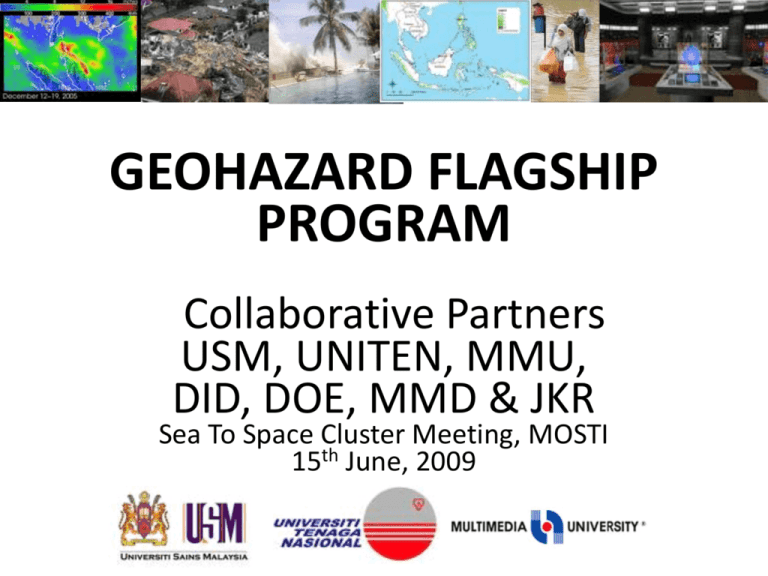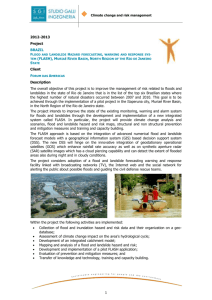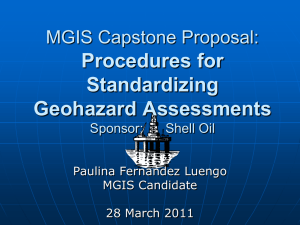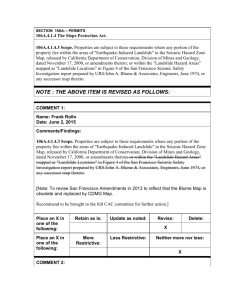usm-uniten-mmu - Multimedia University
advertisement

GEOHAZARD FLAGSHIP PROGRAM Collaborative Partners USM, UNITEN, MMU, DID, DOE, MMD & JKR Sea To Space Cluster Meeting, MOSTI 15th June, 2009 WHAT IS GEOHAZARD? • Incident that occurs in a sudden manner, complex in nature, resulting in the loss of lives, damages to property or the environment as well as affecting the daily activities of local community. • Such incident requires the handling of resources, equipment, frequency and extensive manpower from various agencies as well as effective coordination and the possibility of demanding complex actions over a long period of time. Hillview Before Tragedy Hillview After Tragedy GEOHAZARD FLOODS Flood in Kota Tinggi - 2007 Too Much Water GEOHAZARD MANAGEMENT Geohazard management involves early warning, preparation, prevention, response, recovery, rehabilitation and reconstruction. In 1970s, Malaysia already have the Blue Print in managing flood Through experiences, Malaysia are able to improve and extend the guideline on dealing with flood and other geohazard that has been encountered An efficient and sound geohazard management mechanism was formulated Responsible Agency: Crisis and Disaster Management Directorate, National Security Division (NSD), Prime Minister’s Department INTEGRATED GEOHAZARD MANAGEMENT • However, lacking in a coordinated and integrated geohazard management • Especially on R&D • Utilization of expertise • Utilization of capital resources • Need an integrated and coordinated approach OBJECTIVE • To explore collaboration opportunities with the agencies involved with the S2S cluster • To learn existing initiatives in S2S cluster • To seek possibility of funding parts of the project • To establish the Integrated Geohazard Information System (IGIS) GEOHAZARD PROGRAM Phase I • CONCEPT & PROPOSAL • Inputs from from collaborative partners UNITEN, USM, MMU, DID, JKR, TNB, MMD & etc Phase II • INTEGRATION OF WATER RELATED GEOHAZARD PROGRAM • Identification of Geohazard Focal Areas and Activities Phase III • ESTABLISHMENT OF NATIONAL CENTRE FOR GEOHAZARD AND INTERNATIONAL COLLABORATION • CHIBA UNIVERSITY, CSU, ICHARM, UNESCO IHP PHASE I CONCEPTUALISATION GEOHAZARD PREDICTION & MONITORING System Monitoring (Remote Sensing and GIS) EO Data In-situ Data (Cell phone pictures and videos) Digital Maps (DEM) Disaster Surveillance (Pre-Disaster Monitoring) Disaster Analysis (GeoHazard Map) Models (Flood & Landslides) Database Management (Input Data Knowledge) Publishing (Web, Mobile Phones) Input Data Integrated Geohazard Information System Objective: To establish a central system for collecting, storing, processing, analyzing, and disseminating value-added data and information to support the relevant agencies in the mitigation and relief activities of disaster management in the country • Emphasizes on the utilization of remote sensing technologies, Geographical Information System (GIS) and Global Positioning System (GPS) technologies to provide up-to-date and reliable data to support the three components of disaster management, namely, – (i) early warning, – (ii) detection and monitoring, and _ (iii) mitigation and relief for pre, during and post disaster management activities (create resilient community). GEOHAZARD 1 GEOHAZARD INTELLIGENT MODEL FOR GTD A Geohazard Data Acquisition • Rainfall Induced & Water Flow in Discontinuity • Characterization of Rock Engineering Parameter & Index • Geophysical tools to identified material as hazard risk index • Integrated Geohazard Survey using GPS & Geological Mapping • Characterization of Soil Parameter& Stability • Hydrologic & Hydraulic B Geohazard Integrated Modeling & Generic Information • Erosion & Landslide • Sedimentation • Land Contamination & Water Pollution • Infrastructure Failure • Storm & Flood C D Geohazard Management, Policy and Guidelines for Sustainable Development ENVIRONMENT • Code of Practice (eg. Slope Monitoring) • Management Guideline (eg. EIA & EMP) • Innovative Technologies (eg.GIS and Visualization Modules) SOCIAL ECONOMIC Geohazard Information Processing Centre • INTELLIGENT EXPLANATION FACILITIES (GeoHazard Database Management System) E Geohazard Centralized Management Centre • GIS andTelemetry • Real Time • Sensor • Monitoring INTEGRATED STRATEGY FOR GEOHAZARD DISASTER MITIGATION FOR GTD To assess, monitor, predict and prevent natural hazards PE 1 : ENVIRONMENT & HAZARD DATA ACQUISITION PE2 : ENVIRONMENT & HAZARD INTEGRATED MODELING & GENERIC INFORMATION PE1(a) : Characterization Of Rock Engineering Parameter and Index PE2(a) Filtering Product /Prototype for Land Contamination PE2(b) Land Erosion PE1 (b): Rainfall Induced and Water Flow In Discontinuity PE1 (c): Environment Sensitive Area (ESA) Safe and Intelligent Route Finder (ESASIRF) for Transmission Line PE1 (d): Development of Intelligent Soil Erosion Prediction Model PE3: ENVIRONMENT & HAZARD MANAGEMENT, POLICY AND GUIDELINES FOR SUSTAINABLE DEVELOPMENT PE2 (c): Sedimentation Problem At Power Station PE2(d): Integrated and Multidisciplinary Research on Flood Hazard Assessment PE1(e): Characterization of Soil Parameters and Slope Stability PE4: ENVIRONMENT & HAZARD INFORMATION PROCESSING CENTER PE3(a) Emergency Action Plan for Small and Large Hydro Power Plant PE3(b) : Development of concrete utilizing Fuel Ash From Power Plant PE3 (c): Dam Break Study Modeling & Dam break Mechanism PE4(a) GIS and Mulitcriteria Analysis For Land Suitability Assessment : minimizing landslide hazards PE4 (b): Hazard Management & Information Dissemination PE4(c): GIS and Visualization Modules PE3 (d): Hazard PE4(d): Geohazard CMC Management – intelligent Information Policy & Explanation Facilities Guidelines Geohazard Database Mgmt System PE5: ENVIRONMENT & HAZARD CENTRALIZED MANAGEMENT CENTRE PE5 (a): Centralized Management Center For Geohazard Monitoring ENVIRONMENTAL FRIENDLY AND HAZARD RISK FREE: PROJECT To enhance the environmental management and reduce the hazards Project 2 Characterization of Rock Engineering Parameter Rock Mass, Rock Slope failure & FOS, Rock Boulder Impact to Design Soil Stability Profiles & Factor of Safety Project 4 Characterization of Soil Mechanics Parameter Project 8 Erosion & Landslide Project 3 Rainfall-Induced and Water Flow in Discontinuity Rainfall Induced parameter Impact of Water Flow in Discontinuity Project 1 Development of GeoHazard Assessment Model (GIS and Visualization) Geophysical Parameters Integrated Landslide Model Project 5 Geophysical tools to Identify Materials as Hazard Risk Index Project 13 GeoHazard Centralized Management System Alarm Warning System Database management System Impact Level of Erosion Effect to Dam Simulation Modules Project 9 Sedimentation GeoHazard Model and Mechanism Project 7 Hydrological & Hydraulic Analysis Method Project 6 Alarm Warning System (Sensor) Project 10 Land Contamination & Water Pollution Project 11 Infrastructure Failure Project 12 Storm & Flood Project 14 Hazard Management Information Policy and Guidelines Sensitivity Prediction Loss of Tower Failure of Dam Impact Level of Flooding Assessment of Current Procedures New & Improved Guidelines Hazard Management and Guideline Impact Assessment method GeoHazard Centralised Management Centre (GCMC) Mobile Network: SMS/MMS Escalation Internet Escalation and Report CENTRALISED MANAGEMENT CENTRE •Monitoring system •Control system •Escalation system •Database system •Help desk GIS and Telemetry System for Landslide Monitoring GIS and Telemetry System for Infrastructure Failure (e.g. Dam) GIS and Telemetry System for Sediment Monitoring Geohazard Methodology Site Investigation (e.g.Transmission Tower and Dam) Triggering Factor, System Behavior, Soil and Rock Parameters GeoHazard Database System (GDBS) Satellite Receiver Sensor Real Time Sensor Material and Structure Development of GeoHazard Model Validation (Expert System) Variation and Model Behavior WEB Publishing Real Time Forecasting Code of Practice Policy & Management for Sustainable Development (Social, Economic & Environment) Innovative Technologies Management Guideline (EAP) TYPES OF GEOHAZARD • Program to focus on water-related Geohazard first – Landslide – Flood – Dam break • Methodology is generic – use for other geohazards DATA AVABILITY • • • • MS Access ArcGIS 9 DATA INVENTORY LAND USE MAP TOPOGRAPHY MAP GEOLOGICAL MAP EXISTING SITE INVESTIGATION DATA (BH and MP) TRANSMISSION LINE ACTIVE LINK GIS Layers ACTIVE LINK EXISTING REPORTS •Retaining Wall • Slope • Drainage Maintenance Data Location Indicators for Maintenance Works Inspection Work Notice of Completion Report Notification Completion Certificate Statistics Work Status / Progress Schedule Schedule Financial for of routine Reporting Inspection maintenance EXECUTIVE INFORMATION SYSTEM Work Priority SLOPE MANAGEMENT SYSTEM Site Investigation + Data Inventory Existing Landslide Occurring Area Record TRANMISSION and LINE LOCATION (Plan digitize) GIS database. + Maintenance Records Information Inventory + + + From report and plan (---------------- transmission line data management ---------------------------) MS Access Arc GIS DISASTER MONITORING AND INFORMATION SYSTEM FINLAND ENVISTATE - Situation Awareness System For Natural Disaster Mitigation •Landslide • Flooding ENVISTAB SAR-Interferometric Techniques In Hillslope Stability Monitoring For An Environment Security Monitoring System MMU + UNITEN? DEVELOPMENT OF MALAYSIAN LANDSLIDE MODEL LANDSLIDE HAZARD MANAGEMENT AND INFORMATION DISSEMINATION • Policy • Education • Awareness 3D GROUND MODELLING + GIS +REMOTE SENSING JAPAN ICT MANAGEMENT IN LANDSLIDE HAZARD Benefits of Study/ Program Systematic approach - to handle geohazard problems A geohazard risk map - assist GOVT to focus on identified critical areas Increasing efficiency in monitoring and maintaining the identified areas. A systematic data base for GOVT monitor geohazard. Benefits of Study/ Program A methodology which can be adopted for other region. Towards a more efficient monitoring and maintenance system for GOVT. A report to show need for systematic monitoring and maintenance schedule Benefits of Study/ Program An educational enriching experience and enhancement of the technical knowledge on hazard risk management, stability of soil slope, flood project, dam break analysis and maintenance/remedial works. Capacity building and exposure for the Project Team Members Benefits of Study/ Program A guideline/handbook on the review of existing specifications on geohazard with regard to preventive measures of slope stability, flood and others (appropriate mitigation measures to be taken for various category of critical hazard) PHASE II INTEGRATION OF WATER RELATED GEOHAZARD PROGRAM COLLABORATORS MMU Prof Dr Zaharin Yusoff Dr. Tay Lea Tien Dr. Hairul Azhar Abdul Rashid Dr. Saravanan Muthaiyah Dr. Murali Raman Mr. Jeong Chun Phuoc Mr. Fazidin Jabar Dr. Tan Shing Chiang Dr. Loo Chu Kiong Dr. Aarthi Chandramohan Ms. Teng Hse Tzia COLLABORATORS UNITEN 1. Prof Ir Dr Hj Mohd Nor Mohd Desa 2. AP Ir Dr Lariyah Mohd Sidek 3. AP Dr Norashidah Md Din 4. AP Dr Md Zaini Jamaluddin 5. Dr Rohayu Che Omar 6. Faizah Che Ros 7. Dr Ahmed Hussien Birami COLLABORATORS USM Assoc. Prof Dr. Habibah Lateh Mr. Koay Swee Peng Assoc. Prof Dr. Chan Huah Yong Assoc. Prof Dr. Fauziah Ahmad Dr. Wan Mohd Muhayuddin Wan Ibrahim Assoc. Prof Adam Baharum Assoc. Prof. Dr. Ismail Abustan Dr. Khaled Mohamed Darwish Professor Ruslan Rainis Mrs. Mastura Azmi Mr. Mohd. Haris Ramli Dr. Younus Ahmed Khan GEOHAZARD FLAGSHIP PROGRAM • • • • Geohazard Data Acquisition Geohazard Modelling Geohazard Mitigation Geohazard Management Policy & Guideline • Geohazard Information Processing • Geohazard Centralized Management GEOHAZARD PROJECTS Geohazard Projects @ UNITEN E1: Intelligent GIS and Multi-hazard Risk Map Visualization E2 :Rainfall Induced and Water Flow in Discontinuity E2: Characterization of Rock Engineering Parameter & Index E2: Geophysical tools to identified material as hazard risk index E2: Characterization of Soil Parameter and Stability E6 :Alarm Warning System (Sensor) E3 :Sedimentation Problems E3:Integrated Flood Management E3: Infrastructure Failure (Dam Break) E3 : Erosion and Landslides (Risk Assessment Transmission Tower) E3: Land Contamination and Water Pollution (Erosion and Land Contamination using Biodegradable and Non-degradable Material) GEOHAZARD PROJECTS Geohazard Projects @ USM •Slope stability prediction •Early Warning System •Intelligent Explanation System •Landslide modeling and analysis using remote sensing & GIS •Risk Assessment model of rainfall induced landslide GEOHAZARD PROJECTS Geohazard Projects @ MMU •Command, Control and Crisis Operations Network: A Real-time Crisis Management System in VR •Modelling and Discrete Simulations of Landslide Processes and Their Impacts – On Going •Assessing Flood Vulnerability in Malaysia: Developing a Decision Support System •ICT in Support of Disaster Management in Malaysia: A KMS Approach – On Going •Emergency Preparedness Systems: Role of KM Systems: The Claremont California experience – sponsored by Department of Defense USA (2003-2005) –Completed. INDUSTRIAL PARTNERS • Photronix • Fiber Optic Sensing: • Geotechnical, Civil & Structural Monitoring & Early Warning Detection System ACHIEVEMENTS GEOHAZARD FLAGSHIP PROGRAM Potential Multi-hazard Map base on Terrain Analysis Landslide Hazard Total Areas (Hectare) Low Hazard 2114.887 Moderate Hazard 3793.243 High Hazard 187.759 WORK FLOWS OF SLOPE INVENTORY USING GIS Database development in GIS Connecting slope inventory data with GIS Slope inventory using Microsoft Access Data visualization using GIS Site Observation Remedial Work Plan view Plan View Slope W Analysis Cross-section view Copyrights © 2005 TNB Research Copyrights © 2005 TNB Research This guideline proposed some recommendations for the landslide prevention and control strategy to be used as Risk Management Process: Risk Management Process include the systematic application of management policies, procedures and practices to the tasks of communicating, establishing the context, identifying, analyzing, evaluating, treating, monitoring and reviewing risk Copyrights © 2005 TNB Research This manual documents the field procedures for Inventory, Monitoring, and Evaluation Program for prevention and maintenance of slope. This form of monitoring involves visually inspecting surface conditions within and beyond the right of way along slope profile. Copyrights © 2005 TNB Research The purpose of this manual is to familiarize the ArcGIS and to help the user understand the basic structure of the program. This manual will also provide the basic guidelines to create a simple geo-hazard map (example landslide map) using standard cartographic components. These are skills will be needed in all subsequent practices for preparing Copyrights © 2005 TNB Research COCCOON : Command, Control and Crisis Operations Network A Real-time Crisis Management System in VR COCCOON is a specialized Virtual Reality software that utilizes a huge network of hardware arrays to monitor and analyze crisis situations in realtime, covering over large areas, utilizing multimedia and remote sensing, basically putting all required information onto the hands of the people who can make decisions and take immediate actions to mitigate any crisis. Command, Control & Crisis Operations Network : COCCOON Objectives 4 Major Functions of Coccoon Monitor: Manage: Train: Sensors / Cameras Sensors / Cameras COCCOON SYS 3D Projection System COCCOON SYS 3D Projection System Sensors / Cameras Database Predict: Sensors / Cameras Database Personnel COCCOON SYS 3D Projection System Personnel COCCOON SYS 3D Projection System Personnel Command, Control & Crisis Operations Network : COCCOON Components of Coccoon Telemetry Ceiling Streaming Wall Analysis Wall 3D Floor Cartographic Wall Command, Control & Crisis Operations Network : COCCOON APPENDIX GEOHAZARD PROJECTS DETAILS Remote Sensing • • • • Modelling and Discrete Simulations of Landslide Processes and Their Impacts MOSTI Science Fund, On-going SAR images – such as Radarsat image. Various techniques (such as morphological transformations) to compute the slope, roughness using DEM (digital elevation model). • • • Remote Sensing Extraction of the complex topological information (such as channel / ridge networks, and sub-watershed boundaries) from DEM. Simulation of landslide model to capture the changes temporally. Record of changes in the topological networks and basin geographic boundary. Identification of high potential landslide areas/paths. Fiber Optic Sensing: Geotechnical, Civil & Structural Monitoring & Early Warning Detection System (By: Vijay, Photronix Sdn. Bhd.) Scope of Work Identify Ideal Sensors & Sensing System for EWDS Development of Sensor, System & Testing Embedding AI and Algorithms Development of GUI Threshold, Alarm, Alert & Public Access Parameter Analysis, Integration & Report Pilot Project & PoC Fiber Optic Sensor • Selection of suitable fiber optic sensor (FBG, FPI, LPG, TDR, etc..) • Identify monitoring parameters • Develop sensor packaging & testing to relevant standards • MoS for operation and installation • Performance evaluation Sensing System Fiber Optic Sensor Interrogation System Inpu t Sign al PASS PASS PASS FAIL PASS!! FAIL !! FAIL !! Inpu t Sign al Development of CMS • Determination of mode of communication • Identify user & setting parameters & requirements • Develop GUI, Database & Storage • Incorporation of AI, Threshold, Algorithms • Alarm & Alert Functionality • Public Access Parameter Analysis PARAMETER 1 REPORT REPORT PARAMETER 2 ANALYSIS REPORT PARAMETER N Pilot Project • • • • • • Determination Installation Site SI and Geotechnical Reports Installation and Site Station Monitoring & Maintenance Modifications Approval & Certifications Slope Stability Prediction Objective: Predicting The Failure of Natural Slope and Cut Slope by Calculation (Model) Physical and Biological Approach to Measure The Stability of The Soil Method: • Studying on soil structure and slope behavior • Set up a Testing Site and Studying the Behavior of Soil • Creating New Model • Finding Better Approach on Slope Stability Mechanism Early Warning System Objective • Giving Warning and Alert to Surroundings through Internet and SMS by Real Time • Providing Real Time Data to Administrator (Officer) for Decision Making Method • Real Time Connection Site to Center • Network Center to Site Surrounding and Authority • Server for Data Control • SMS and Email System for Information Distribution Intelligence Explanation System (IES) Intelligence Explanation System Multilanguage Automatic Landslide News Collection Landslide Filtering Control Existed Function New suggest function Intelligence Explanation from existed database and Google Landslide Animation Video & Photos System Setting -Upload Landslide article -Upload Landslide Photo -Upload Landslide Video -News Collection -Explanation for key word System Setting - Newspaper Intelligence Explanation System (IES) Objective: • To provide clear, better understanding on landslide knowledge. • To purpose more intelligent search method. • To provide more dynamic system setting. • To provide more user friendly system. • To keep and landslide news and knowledge Intelligence Explanation System (IES) Method: 1. Multilanguage Add New Language Upload landslide article based on the language Insert explanations in Multilanguage Read landslide article (Multilanguage selection) Intelligence Explanation System (IES) 2.Landslides News Collection Insert URL of newspaper Newspaper defined by admin will be filter Intelligence Explanation System (IES) 3.News Filtering Control Based on given URL, news will be filtering Filter news content has landslide term Re-filter it to remove news which is related to Politic Save landslide news based on category language Download landslide news (work offline) Research Framework Compilation of existing & additional data Data conversion & cleaning Understanding Flood behaviour Mining the data For possible patterns & trends Assess management options Decision Support System Strategy formulation Implementation strategies Flood warning System Knowledge base Training & Education materials Knowled ge base Beneficiaries Government Training & education al materials NGOs What-if scenarios Knowledge systems Decision Support Systems Corporate Flood warning system Strategic plans Strategic Systems Tier 2 Tier 3 Public Tier 1 Past flood (50 years) Meteorologic al (50 years) Socio-economic Flood victim Landuse Objectives • To analyse climatic and landform parameters to assess the flood-prone areas and to trace the history of floods in Malaysia using secondary data • To assess the risk the people and the property face in the flood-prone areas and to work out the details of the damages in case of floods occurring • To develop strategies in reducing the impact of flood hazards and to design precautionary intervention, mitigation measures and prediction and preparedness • To integrate secondary and filed data so as to get a sensible and sensitive database for flood management • To develop a Decision Support System so as to take timely decisions for managing the flood-prone areas for meeting the emergencies and working out long-term solutions and strategies • To develop a knowledge-based education and training on flood vulnerability management Deliverables • Decision Support System (DSS) • Strategic plans intended to reduce intensity of the flood hazards, strategic plans for precautionary intervention, mitigation of flood effects • Education and training modules on flood management • Structured knowledge base Prior Experience 1. ICT in Support of Disaster Management in Malaysia: A KMS Approach – project valued at RM132,800 – Status – 95% completed 2. Emergency Preparedness Systems: Role of KM Systems: The Claremont California experience – sponsored by Department of Defense USA (2003-2005) –Completed. Policy and Guidelines Problem Statement Information technology can assist organizations in managing complex and dynamic environments (Burnell et al., 2004) Dealing with earthquakes, terror threats and other forms of natural or human-made disasters are examples of complex and dynamic environments (Kostman, 2004) Most systems designed to support hazard mitigation efforts deal primarily with design and systems development issues (Jennex, 2005, 2008) However, systems designed to support hazard mitigation efforts should not exclude policy and guidelines or impact assessment from a socio-policy dimension Policy and Guidelines Objectives Given the above, the focus of the policy and guidelines segment of this research initiative are as follows: 1. To conduct an impact assessment of Geohazard systems from a socio-economic and organizational dimension, within the given environment 2. To assess the feasibility of such systems – end user adoption and use 3. To ascertain critical success factors from soft sciences namely: adoption issues, evaluation, managerial support, leadership and other knowledge driven imperatives Policy and Guidelines Key guiding principles for designing emergency/hazard management systems from a policy and socio-impact perspective (Turoff et al. 2004; Turoff 2002,2000,1972; Jennex 2004, Lee and Bui 2000; Campbell et al., 2004): Support collaborative knowledge sharing Support drills and simulation Enhance group coordination Permit free exchange of information Provide timely and relevant information to responders Enhance and not hinder emergency management efforts Policy and Guidelines Research Framework Hazard Environment Attributes Complex Dynamic Unstructured Continuous Training Processes Hazard Management “Fit” Creat Technology e Apply Design Knowledge Characteristics Ad-hoc Decentralized Contextualized Culture Policy & Guideline Research Framework Generic issues to be considered for implementing/develop a Geohazard Systems: Incorporate system into all centralized coordinated efforts Dedicated staff to update, and maintain system designed Extend use of system to include intra and inter-organizational dimension Think through the legislative impact – none in Malaysia currently in using such systems Ensure “fit” between system and existing processes Towards a knowledge sharing culture in managing hazards Policy & Guidelines Research Approach and Tentative Time Objectives 1. To conduct an impact assessment of Geohazard systems from a socioeconomic and organizational dimension, within the given environment 2. To ascertain critical success factors from soft sciences namely: adoption issues, evaluation, managerial support, leadership and other knowledge driven imperatives Objective 1 Timeline Method First 6 months post implementation Objective 2 Months 6-12 The tentative method for data collection for the above will involve a combination of interviews, case data and also surveys




